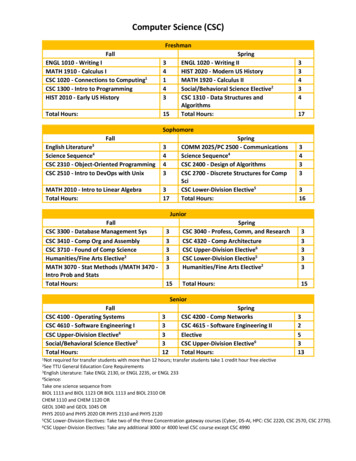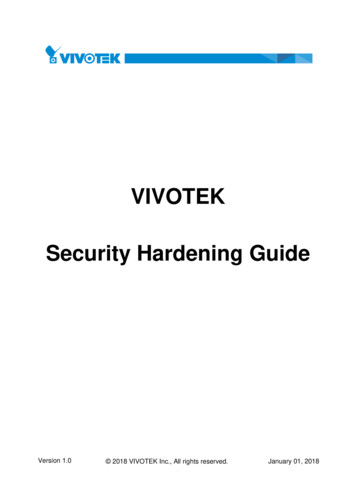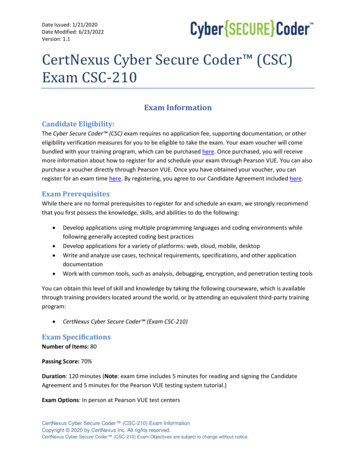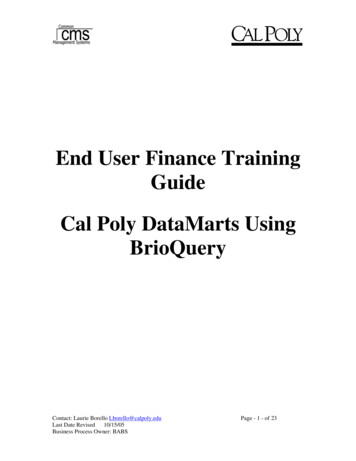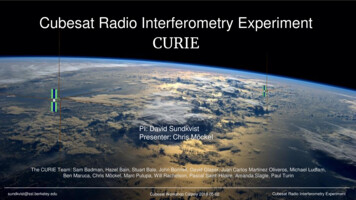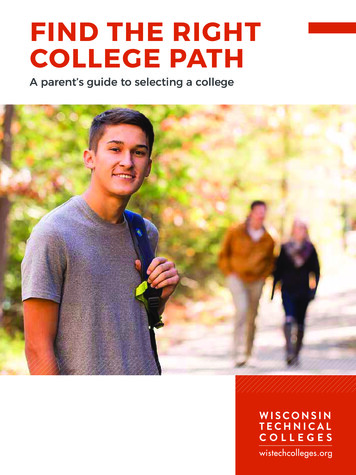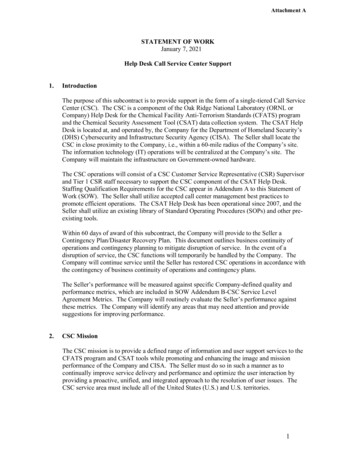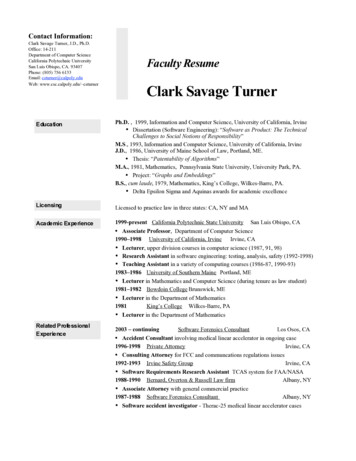
Transcription
Contact Information:Clark Savage Turner, J.D., Ph.D.Office: 14-211Department of Computer ScienceCalifornia Polytechnic UniversitySan Luis Obispo, CA. 93407Phone: (805) 756 6133Email: csturner@calpoly.eduWeb: www.csc.calpoly.edu/ csturnerFaculty ResumeClark Savage TurnerEducationPh.D. , 1999, Information and Computer Science, University of California, Irvine Dissertation (Software Engineering): “Software as Product: The TechnicalChallenges to Social Notions of Responsibility”M.S., 1993, Information and Computer Science, University of California, IrvineJ.D., 1986, University of Maine School of Law, Portland, ME. Thesis: “Patentability of Algorithms”M.A., 1981, Mathematics, Pennsylvania State University, University Park, PA. Project: “Graphs and Embeddings”B.S., cum laude, 1979, Mathematics, King’s College, Wilkes-Barre, PA. Delta Epsilon Sigma and Aquinas awards for academic excellenceLicensingLicensed to practice law in three states: CA, NY and MAAcademic Experience1999-present California Polytechnic State University San Luis Obispo, CA Associate Professor, Department of Computer Science1990–1998 University of California, IrvineIrvine, CA Lecturer, upper division courses in computer science (1987, 91, 98) Research Assistant in software engineering: testing, analysis, safety (1992-1998) Teaching Assistant in a variety of computing courses (1986-87, 1990-93)1983–1986 University of Southern Maine Portland, ME Lecturer in Mathematics and Computer Science (during tenure as law student)1981–1982 Bowdoin College Brunswick, ME Lecturer in the Department of Mathematics1981King’s College Wilkes-Barre, PA Lecturer in the Department of MathematicsRelated ProfessionalExperience2003 – continuingSoftware Forensics ConsultantLos Osos, CA Accident Consultant involving medical linear accelerator in ongoing case1996-1998 Private AttorneyIrvine, CA Consulting Attorney for FCC and communcations regulations issues1992-1993 Irvine Safety GroupIrvine, CA Software Requirements Research Assistant TCAS system for FAA/NASA1988-1990 Bernard, Overton & Russell Law firmAlbany, NY Associate Attorney with general commercial practice1987-1988 Software Forensics ConsultantAlbany, NY Software accident investigator - Therac-25 medical linear accelerator cases
Research AbstractNote that my research has three foci. My efforts are multidisciplinary to support a“systems view” of computing and software engineering in context: social-legal,traditional engineering, and educational.1.2.3.Software engineering processes are inadequate to the task of producing safe,reliable systems. They always will be. This is not a new problem. However,software adds a new dimension to the problem because its unique nature rendersmuch of the traditional engineering and legal wisdom inapplicable. Safetyconstraints for artifacts of engineering processes are derived from bothengineering and social expectations. Judges and lawyers currently struggle toderive reasonable legal expectations with respect to the software artifact. Likethe engineers, they have mainly the methods and tools based on models createdfor traditionally engineered artifacts. My research questions the adequacy ofthe basic engineering and legal models used to address software safety andproducts liability. Its goal is to build a rational model of software engineeringresponsibility. I have worked on 7 refereed conference papers to present resultsin this area since coming to Cal Poly. I find a lot of student interest in thisresearch. In an offshoot of this work, “open source” issues are explored as amore effective means to debug design ideas where public safety is at issue. Thework seeks to publically expose underlying design ideas in safety-criticalsoftware in a way that is analagous to the law of patent. We find that currentlaw allowing copyright of the opaque executable and trade secret protection forthe readable source code to be inadequate engineering practice and not in linewith basic historical notions of the purpose of copyright. I have given a talk, coauthored a Technical Report and implemented the some of these ideas in theproposed Cal Poly Intellectual Property Policy.I also work with Small Satellite Communication Systems and Software. Thecurrent trend to do more for less cost has led to interest in “Smaller, Cheaper,Faster, Better” missions. This becomes more practical with the rapid advance inminiaturization and decreased power consumption. Together with Jordi PuigSuari (Aerospace, Cal Poly) and Bob Twiggs (Aerospace, Stanford), we havedeveloped “CubeSat” standards for construction and launch of small satellites 4inches on a side and less than 1 Kg in mass. We have developed a deployermechanism (P-POD) based on these standards (patent applied for). Our CubeSateffort now involves a consortium of nearly 15 other Universities who build toour standards and contract with us as integrator for launch (now scheduled forearly 2005). The Lab at Cal Poly, built on our MDSTL grant, has become thecenter for integration testing of the CubeSats as well as the development basefor our own satellite, PolySat. The lab has become a leader in many of the smallsatellite support issues plaguing developers. Research problems include wirelessnetworking for constellations of CubeSats, ground systems to interface withCubeSats and embedded control software. I worked on 4 conference papers inthis area and have generated about 200,000 in grants as a co-PI with JordiPuig-Suari.I have interests in Software Engineering Education. I am a member of thesoftware engineering committee that developed and obtained final approval forthe first B.S. degree in Software Engineering in the state of California. Ideveloped the first course in our Capstone sequence (RequirementsEngineering) for Software Engineering majors.I have modified ourProfessional Responsibilities course to incorporate labs where technology istightly integrated with the ethical and professional issues it often presents. Icontinue my involvement with the core Software Engineers at Cal Poly as weattempt to characterize and evaluate the effectiveness of our Capstone sequence,a course sequence unique in the world to Cal Poly. I’ve worked on 4 refereedconference papers in this area.
Grants and ResearchFundingMy funding efforts have been multidisciplinary in nature, joint with Prof. Puig-Suariin the Aerospace Engineering Department. They are aimed at creating the CubeSatlaboratory in the ATL and continuing to support small satellite systems. I list thefollowing successful grant proposals:1.2.3.4.PatentsReview and Referee1.“CubeSat Spacecraft and Development Launcher System,” Robert Twiggs(Stanford), Jordi Puig-Suari (Cal Poly), Clark Turner (Cal Poly), Nov. 2000.Stanford University is pursuing the patent application.1.2.Springer Academic Publishers, reviews for Software Quality Journal 2004International Association of Science and Technology for Development,conference paper reviews for Software Engineering and Applicationsconference, 2001-2002International Society for Law and Technology, LawTech conference referee,2000-2002.Wiley and Sons, review and consulting regarding a proposed Ethics text, 20023.4.Publications 33,116 “Development of Attitude Control Systems for Pico-Satellites,”from C3RP under Dr. Opava’s ONR grant. Co-PI with Professor Jordi PuigSuari of the Aerospace Dept. 2004. 25,000 “Development of Launch Interfaces for the CubeSat Program,”from C3RP under the ONR grant. Co-PI with Professor Puig-Suari of theAerospace Department. 2002. 150,000 “Multidisciplinary Space Technology Education at Cal Poly,”California Space Flight Competitive Grants Program of the CaliforniaTechnology, Trade and Commerce Agency. Co-PI with Professor Puig-Suari ofthe Aerospace Department. 2001.Collaborator, NSF grant “Improving the Education of Software Testers”funded and implemented by Cem Kaner at Florida Institute of Technology.2001.Peer Reviewed Conference publications:1. Cumberland, Turner, An Ad Hoc Evaluation of Workflow Modeling Tools,Proceedings of the Eighth IASTED International Conference on SoftwareEngineering and Applications, Cambridge, MA., Nov. 2004.2. Nico, Turner, Nico, Insecurity by Contract, Proceedings of the Eighth IASTEDInternational Conference on Software Engineering and Applications,Cambridge, MA., Nov. 2004.3. Turner, Fisher, Stearns, Learning Software Engineering by Doing: ProgressReport on a Capstone Sequence Involving Student Managed Teams, Proceedingsof the 2004 American Society for Engineering Education Pacific SouthwestSection Conference, University of the Pacific, Stockton, CA., Apr. 2004.4. Khosmood, Turner, Discovery in Negligence Analysis:Evolution of aSufficiently Safe Spec, Proceedings of the Seventh IASTED InternationalConference on Software Engineering and Applications (SEA 2003), Marina delRey, CA. Nov. 20035. Nico, Turner, Kearns, The Death of the Programmer? Proceedings of theSeventh IASTED International Conference on Software Engineering andApplications (SEA 2003), Marina del Rey, CA., Nov. 2003.
6.7.8.9.10.11.12.13.14.15.16.17.Stearns, Dalbey, Turner, Kearns, Report: A Capstone Project involving aHundred Students, for an Industrial Partner,” Proceedings of the InternationalConference on Engineering Education, Valencia, Spain, Jul. 2003.Buttschardt, Turner, Making a Case for Amateur Spectrum through Research,Education and Industry Cooperation,” Proceedings of the Twentieth AMSATNA Space Symposium, Ft Worth, TX, Nov. 2002.Turner, Fox, Richardson, Strict Products Liability for Software Code Defects,Proceedings of the Third International Conference on Law and Technology(ISLAT), Cambridge, MA. Nov. 2002.Hatalsky, Corwin, and Turner, The Modification Process: A Practical Means toUnderstand and Enhance the Software Requirements Engineering Process,Proceedings of the Sixth IASTED International Conference on SoftwareEngineering and Applications, Cambridge, MA., Nov. 2002.Turner, Fox, When Bad Code Comes From Good Specs, Proceedings of theSixth IASTED International Conference on Software Engineering andApplications, Cambridge, MA., Nov. 2002.Puig-Suari, Turner, Twiggs, Cubesat: The Development and Launch SupportInfrastructure for Eighteen Different Satellite Customers on One Launch, 15 thAnnual AIAA/USU Small Satellite Conference, Logan, Utah., Aug. 2001.Turner, Khosmood, Rethinking Software Process: The Key to NegligenceLiability, Proceedings of the Fifth IASTED International Conference onSoftware Engineering and Applications, Anaheim, CA., Aug. 2001.Stearns, Meldal, Turner, Ten Pounds in a Five Pound Sack: ProvidingUndergraduate Software Engineering Students with Technical ManagementExperience, International Conference on Engineering Education, Oslo, Norway,Aug. 2001.Puig-Suari, Turner, Ahlgren, Development of the Standard CubeSat Deployerand a CubeSat Class Picosatellite, IEEE Aerospace Conference, Big Sky, MT.,2001.Turner, Richardson, Software and Strict Products Liability: TechnicalChallenges to Legal Notions of Responsibility, Proceedings of the IASTEDInternational Conference on Law and Technology, San Francisco, CA., Oct.2000.Puig-Suari, Schoos, Turner, Wagner, Connolly, Block, CubeSat Developmentsat Cal Poly: The Standard Deployer and PolySat,” Proceedings of the 45thAnnual meeting of SPIE, the International Society for Optical Engineering, SanDiego, CA., Jul. 2000.Turner, Richardson, King, Legal Sufficiency of Testing Processes, Proceedingsof the 15 th International Conference on Computer Safety, Reliability andSecurity (SAFECOMP ’96), Vienna, Austria, Oct.1996.Journal publications:18. Turner, Risk Management for Safety-Critical Software: A Unique Problem onthe Horizon, The Technology Report, A Publication of the Technology Sectionof the Academy of Legal Studies in Business, Spring/Summer, 2001.19. Leveson and Turner, An Investigation of the Therac-25 Accidents, IEEEComputer, Vol. 26, no. 7, Jul, 1993. *Note: There have been numerousrepublication of “An Investigation of the Therac-25 Accidents” in compilationsand textbooks.20. Sganga, Turner, Orange County Lawyer’s Salary Survey, Orange CountyLawyer, Sept. 1991.
Technical Reports:21. Swann, Turner, Executable Code is not the Proper Subject of Copyright Law,Cal Poly State University Technical Report: CPSLO-CSC-04-02, 2004.22. Nico, Turner, Kearns, The Death of the Programmer? Cal Poly State UniversityTechnical Report: CPSLO-CSC-02-01, 2002.23. Turner, Richardson, Software Defect Classes and No-fault Liability, UCI-ICSTechnical Report No. 99-17, Department of Information and Computer ScienceUniversitty of Califirnia, Irvine, CA. 92697-3425, 1999.24. Leveson, Turner, An Investigation of the Therac-25 Accidents, UCI-ICSTechnical Report No. 92-108, Department of Information and ComputerScience, University of California, Irvine, CA. 1992.Book chapter publication:25. Kling and Turner, The Information Labor Force, published in Kling, Olin,Poster, Postsuburban California: The Transformation of Orange County SinceWorld War II, UC Press, 1991.Presentations.1.“Learning Software Engineering by Doing: Progress Report on a CapstoneSequence Involving Student Managed Teams,” delivered to the 2004 AmericanSociety for Engineering Education Conference, University of the Pacific,Stockton, CA., Apr. 20042. “How Programmers Should be Engineering Software,” joint with Dr. Phil Nicoto the Cal Poly community sponsored by UPE Honor Society. Feb. 20043. “Copyright as Disincentive to Software Safety Analysis,” presentation to CalPoly community sponsored by Cal Poly LUG. Feb. 2004.4. “Underpinnings of Copyright, or, Life, Death and Copyright, Really!” apresentation for the Cal Poly Library Series on Feb. 13, 2003.5. “Software and Strict Products Liability: Technical Challenges to Legal Notionsof Responsibility,” a talk delivered to the IASTED International Conference onLaw and Technology, San Francisco, CA., Oct. 2001.6. “CubeSat Developments at Cal Poly: The Standard Deployer and PolySat,”Jordi Puig-Suari, Jeremy Schoos, Clark Turner, Tyler Wagner, Ryan Connolly,Richard Block, the 45th International Symposium on Optical Science andTechnology, San Diego, CA., Jul. 2000.7. “Legal and Economic Issues with Open Source Software,” a talk delivered to theCal Poly Linux Users Group on Apr. 13, 2000.8. “Software as Product: The Technical Challenge to Social Notions ofResponsibility,” a Computer Science Colloquium, Cal Poly State University,San Luis Obispo, CA., Oct. 1999.9. “When Ontogeny Inverts Phylogeny, Regulation in a Fully Connected World?”This panel discussion covered the implications of internet commerce;technology whose deployment preceded the chance to regulate it. The panel washeld at the California Software Symposium (CSS ’98), sponsored by USC CSEand UCI IRUS, Irvine, CA; Oct. 1998.10. “Liability for Safety-Critical Software Flaws” presented to the Bay AreaRoundtable - Irvine Research Unit in Software (IRUS), in Palo Alto, CA. onDec. 12, 1997.11. Invited software engineering and law commentator during the ethics discussionat the meeting of the Southern California Software Process Improvement
Network sponsored by the Irvine Research Unit in Software at the University ofCalifornia, Irvine., Dec. 6, 1998.12. “Legal Sufficiency of Testing Processes” - presentation of our paper to theSAFECOMP ’96 conference in Vienna, Austria on Oct. 21, 1996.13. “The Software Process and Safety-Critical Testing,” presentation to theDepartment of Computer Science at the Technical University of Vienna, Vienna,Austria on Oct. 17, 1996.14. Invited Keynote speaker on the Legal Sufficiency of Software TestingProcesses at the 9th International Software Quality Week conference, SanFrancisco, May 24, 1996.Workshops and otherContinuing Education1.2.3.4.5.6.Poster Presentations1.2.Student Mentoring“Grounding Student Retention and Recruitment in Computer Science Programsin Sound Research Methodology and Data: a CSU System-wide Workshop,”Apr. 20042004 West Coast Space Symposium, College of San Mateo, Apr. 20041st Annual CubeSat Developer’s Workshop, Cal Poly, Apr. 2004Technical Work Group / Symposium, Storage Networking Industry Association,San Jose, Oct. 2002.DARPA/NSF Study on Human-Robot Interaction (Invitation Only Workshop) atCal Poly State University, Sept. 2001.Java Test Development, SunTest / Irvine Research Unit in Software, Nov. 1996.“Internalizing Risk: Making Risk Consideration a Routine Part of the SafetyCritical Software Process,” California Software Symposium, (CSS ’97),sponsored by IRUS and USC CSE, University of California, Irvine, Nov.1997.“Internalizing Risk: Making Risk Consideration a Routine Part of the SafetyCritical Software Process,” 19th International Conference on SoftwareEngineering (ICSE ’97), Boston, MA. Mar. 1997.A sample of recent Senior Projects supervised:1. Noe, “Design and Implementation of the Communcations Subsystem for the CalPoly CP2 CubeSat System,” (CPE, 2004) It involved design and implentationof a board, hardware and software, to implement the communications subsystemfor the Cal Poly CubeSat. This senior project won the Accenture Scholarshipaward for outstanding senior project in CPE. He is planning an M.S. inAerospace Engineering here at Cal Poly.2. Swann, “Software and the Social Bargain.” (CSC, 2004) This project develops ahistorical notion for the purpose of copyright and shows a mismatch in itsimplications for executable code. He now works at Microsoft Corporation.A sample of recent Master’s Theses supervised:1. Pond, “RapidGUI.net: An online collaborative prototyping tool designed tofacilitate communcation between develolper and end-user on early user-interfacerequirements,” defended and submitted Spring 2004. This author explores someuser-interface issues in distributed collaboration on software requirements workby building a prototype system to solve the problem. He took a job at NorthrupGrumman.2. Sosinski, “Electronic Votings Systems: A Requirements Analysis,” defended andsubmitted Spring 2004. The author uses safety-critical analyses to show defectsin Diebold’s software requirements. He currently attends McGeorge School ofLaw in Sacramento.
Teaching philosophyTeaching is my main interest. I enjoy working with students. I teach with theexpectation of hard work, some frustration, synthesis and discovery. I will workwith any student willing to develop the skills necessary to master the class material.The brightest of students often challenge me to make the course worth their time andeffort. I encourage these students to go beyond the standard course material towardsthe goal of systems level thinking. After all, computers and software are mainly putto a specific purpose in some other problem domain.I measure my teaching success by: (1) the success of my students in mastering thebasic course material and (2) their ability to use the basic material to synthesizesolutions to new problems.I continue to encourage and facilitate undergraduate student research as a part of myown continuing work. I maintain a three pronged multidisciplinary researchprogram: (1) in order to keep my teaching relevant to the state-of-the-art (and thesystems nature of computing and software); and, (2) to enhance student learning byencouraging involvement in the more accessible aspects of my research.Teaching Recognition1.2.3.4.Sample CoursesTaught, Created andModified Computer Science Teacher of the Year awarded by Cal Poly ComputerScience students (ACM) 2002.Nomination for “Distinguished Educator Award,” CFA, 2002.Nomination by the Society for Women in Engineering for “Most SupportiveProfessor” Spring 2001.Professor of the Year awarded by Cal Poly Computer Science students (ACM)2000.Requirements Engineering , CPE 402 I developed the CPE 402 course in 2000 as part of our planned B.S. degreein Software Engineering at Cal Poly. Our program is now in place as thefirst B.S. in Software Engineering in the State of CaliforniaProfessional Responsibilites (Computer and Software Ethics), CSC 300 Proposed (and the Dept. approved) a change to this the ProfessionalResponsibilities course to introduce a “learning by doing” element toengineering ethics: a lab section where technology is tightly integrated intothe ethics instruction. The modified course is listed in the new 2006-2008catalog and will form the basis to write a textbook (no such textbook toaccompany a Computer Ethics course with lab assignments exists as yet.)Graduate Software Engineering I, Software Requirements, CSC 508Graduate Software Engineering II, Software Design, CSC 509Basic Software Engineering I, CPE 205Object Oriented Programming in Java, CPE 101Courses below taught at other institutions prior to coming to Cal Poly: Software Tools and Methods Structured Programming in PASCAL Calculus; differential, integral, multi-variate Introduction to Probability and Statistics Social Impacts of Computing
Service ActivitiesService to the University:1.2.3.CPIQ Board (Cal Poly Innovation Quest), tasked as Cal Poly liason with CalPoly Innovation Quest, a nonprofit corporation designed to fund Cal Poly seniorprojects and master’s theses with commercial potential. Summer 2004Intellectual Property committee tasked with creation of a new IntellectualProperty Policy for Cal Poly. Chair 2002-2004.California Space Day, a day of meetings and discussions with California’selected representatives in Sacramento to explain the need for funding of spaceeducation projects. Spring 2002.Service to the College of Engineering:4.CENG Project Center Task Force tasked with creation of some of the designconcepts for the Bonderson center. I represented CSC in this Task Force. 20012002.Service to the Department of Computer Science:5.6.7.8.Graduate Committee in the Department of Computer Science. 2004Colloquium Series for the Department of Computer Science, Spring 2004Faculty Advisor:a. Cal Poly Linux Users Group 2000-2004b. Cal Poly Amateur Radio Club 2000-2004c. Graduate Student Association 2003.Software Engineering committee in the Department of Computer Science. Wedeveloped the proposal for the B.S. program in Software Engineering that wasapproved and is now implemented at Cal Poly. 1999-2004.Service to the .3.4.5.6.FCC Amateur Radio License Instructor on topics such as RF safety, basictheory of antennas and modulation / demodulation techniques for the Cal PolyAmateur Radio Club annual amateur radio licensing classes. 2002-2004.Conference session Chair, Software Requirements session / Software Designand Development for the 2002, 2003 and 2004 Software Engineering andApplications conferences.Conference paper reviewer, Software Engineering and Applicationsconference at several conferences 2000-2003.Invited speaker, TenayaHall panel discussion on Napster, 2001.Board of Directors, Wesley Foundation, an organization of the UnitedMethodist Church that provides housing close to campus and activities for allCal Poly (and other college) students in the San Luis Obispo area. 2001-2004IASTED (International Association of Science and Technology forDevelopment)IEEE, Institute for Electrical and Electronics EngineersACM, Association for Computing MachineryASEE, American Society for Engineering EducationCPSR, Computer Professionals for Social ResponsibilityEFF, Electronic Frontier Foundation
7.8.Personal InterestsSNIA , Storage Networking Industry Association (membership for Universityand students enhancing Software Engineering project access.)State Bar Association of California (presently inactive)I have been an amateur radio operator since age 14. I hold an Amateur Extra Classlicense from the FCC. I build and repair radio transceivers as a hobby. I have beencertified as a Volunteer Examiner and am qualified to give Amateur Radio LicenseExaminations for the FCC. I am a proficient morse code operator and enjoy thepractical aspects of worldwide shortwave communications. I like to run distances of5 – 10 miles every day or two and enjoy local road races. I play guitar andmandolin and enjoy bluegrass music.
4. Collaborator, NSF grant "Improving the Education of Software Testers" funded and implemented by Cem Kaner at Florida Institute of Technology. 2001. 1. "CubeSat Spacecraft and Development Launcher System," Robert Twiggs (Stanford), Jordi Puig-Suari (Cal Poly), Clark Turner (Cal Poly), Nov. 2000.

